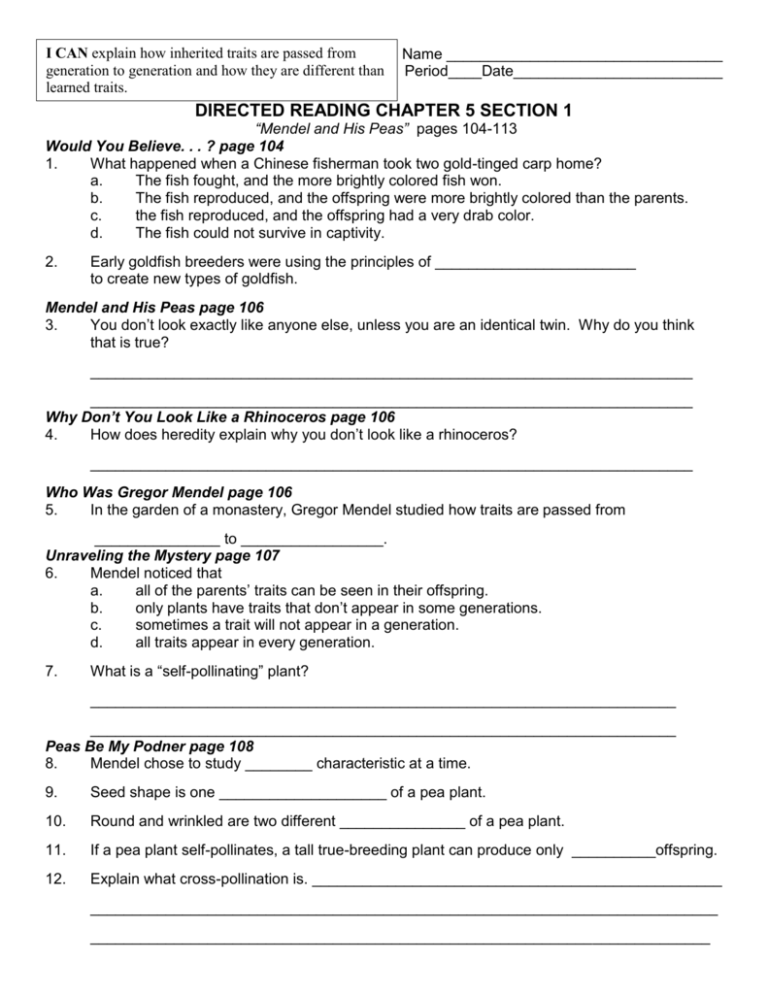print - Mrs. Plankenhorn (Science)
advertisement

I CAN explain how inherited traits are passed from generation to generation and how they are different than learned traits. Name _________________________________ Period____Date_________________________ DIRECTED READING CHAPTER 5 SECTION 1 “Mendel and His Peas” pages 104-113 Would You Believe. . . ? page 104 1. What happened when a Chinese fisherman took two gold-tinged carp home? a. The fish fought, and the more brightly colored fish won. b. The fish reproduced, and the offspring were more brightly colored than the parents. c. the fish reproduced, and the offspring had a very drab color. d. The fish could not survive in captivity. 2. Early goldfish breeders were using the principles of ________________________ to create new types of goldfish. Mendel and His Peas page 106 3. You don’t look exactly like anyone else, unless you are an identical twin. Why do you think that is true? ________________________________________________________________________ ________________________________________________________________________ Why Don’t You Look Like a Rhinoceros page 106 4. How does heredity explain why you don’t look like a rhinoceros? ________________________________________________________________________ Who Was Gregor Mendel page 106 5. In the garden of a monastery, Gregor Mendel studied how traits are passed from _______________ to _________________. Unraveling the Mystery page 107 6. Mendel noticed that a. all of the parents’ traits can be seen in their offspring. b. only plants have traits that don’t appear in some generations. c. sometimes a trait will not appear in a generation. d. all traits appear in every generation. 7. What is a “self-pollinating” plant? ______________________________________________________________________ ______________________________________________________________________ Peas Be My Podner page 108 8. Mendel chose to study ________ characteristic at a time. 9. Seed shape is one ____________________ of a pea plant. 10. Round and wrinkled are two different _______________ of a pea plant. 11. If a pea plant self-pollinates, a tall true-breeding plant can produce only __________offspring. 12. Explain what cross-pollination is. _________________________________________________ ___________________________________________________________________________ __________________________________________________________________________ Mendel’s First Experiment page 109 13. Look at Figure 6. What happened when Mendel crossed plants that had round seeds with plants that had wrinkled seeds? ___________________________________________________________________________ 14. For each characteristic, Mendel called the trait that always appeared ___________________ and the trait that seemed to disappear __________________________. Mendel’s Second Experiment page 109 15. When the first generation of plants was allowed to self-pollinate, as shown in Figure 6, a. all of the offspring had the recessive trait. b. some of the offspring had the recessive trait. c. all of the offspring had the dominant trait. d. the first-generation plants could not produce offspring. A Different Point of View page 110 16. Mendel counted the number of plants with each trait in the ________________ generation. 17. Take a minute to read the Math Break on page 110. In the table of Mendel’s results, the dominant-to-recessive ratio for each trait is a. about 1 : 3 b. about 3 : 1 c. about 1 : 2 d. about 2 : 1 A Brilliant Idea page 111 18. Each parent donates one set of instruction, now known as _____________, to the offspring. 19. Two forms of the same gene, one from each parent, are known as _____________________. Choose the term in Column B that best matches the phrase in Column A, and write the corresponding letter in the space provided. Column A Column B _____ 20. used to visualize the combinations of alleles from the parents a. genes _____ 21. the inherited combination of alleles b. Punnett squares _____ 22. the organism’s inherited asppearance c. genotype _____ 23. sets of instructions for inherited characteristics d. phenotype 24. Look at Figure 8 on page 112. What combinations of alleles will result in plants with purple flowers?_______________________________________________________________ What Are The Chances? page 112 25. Offspring are ____________________ likely to inherit either allele from either parent. 26. The probability that you would toss two heads in a row with a coin is _________percent. Page 113 27. Were Mendel’s ideas immediately accepted by the scientific community when he published his results? Explain. ___________________________________________________________________________ ___________________________________________________________________________








